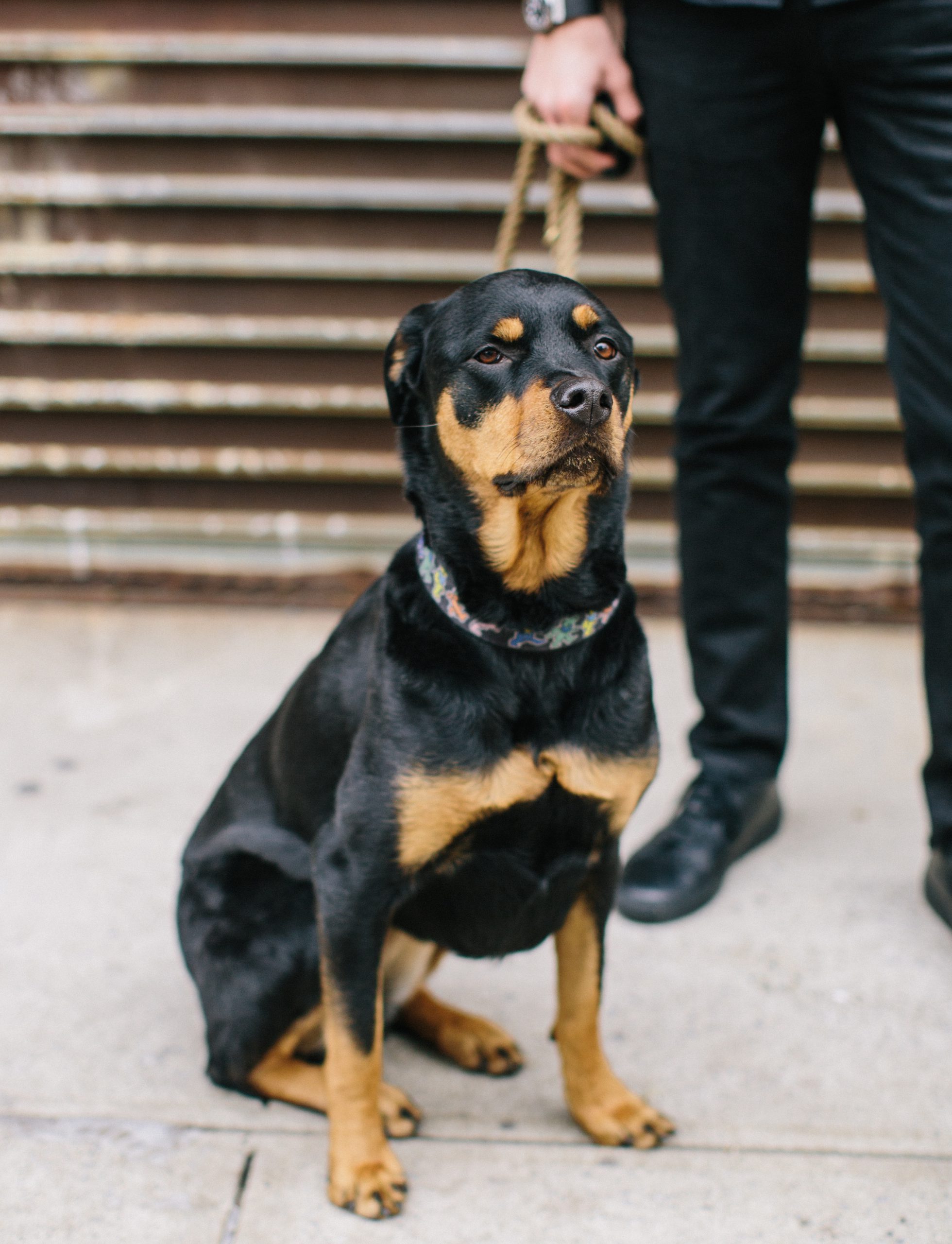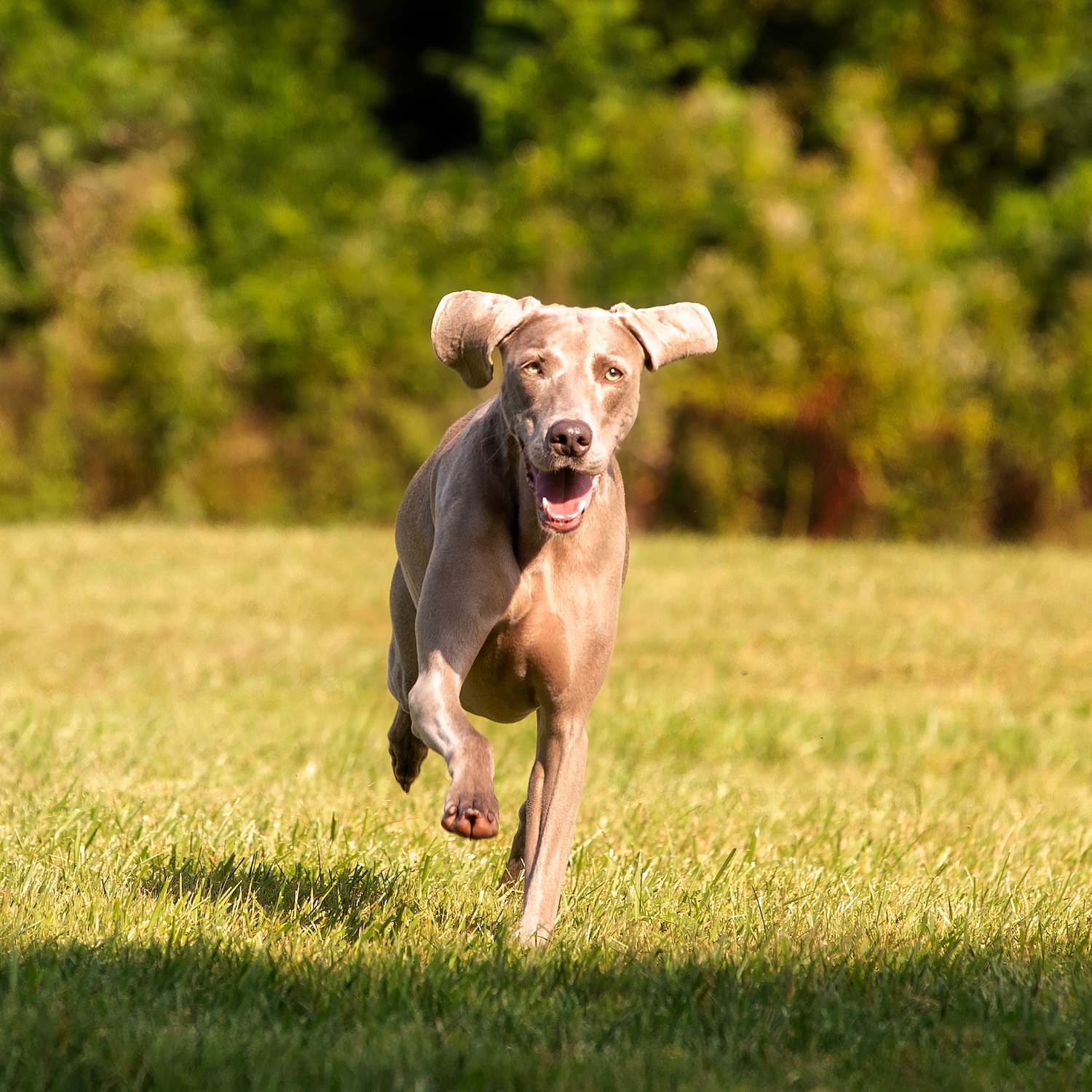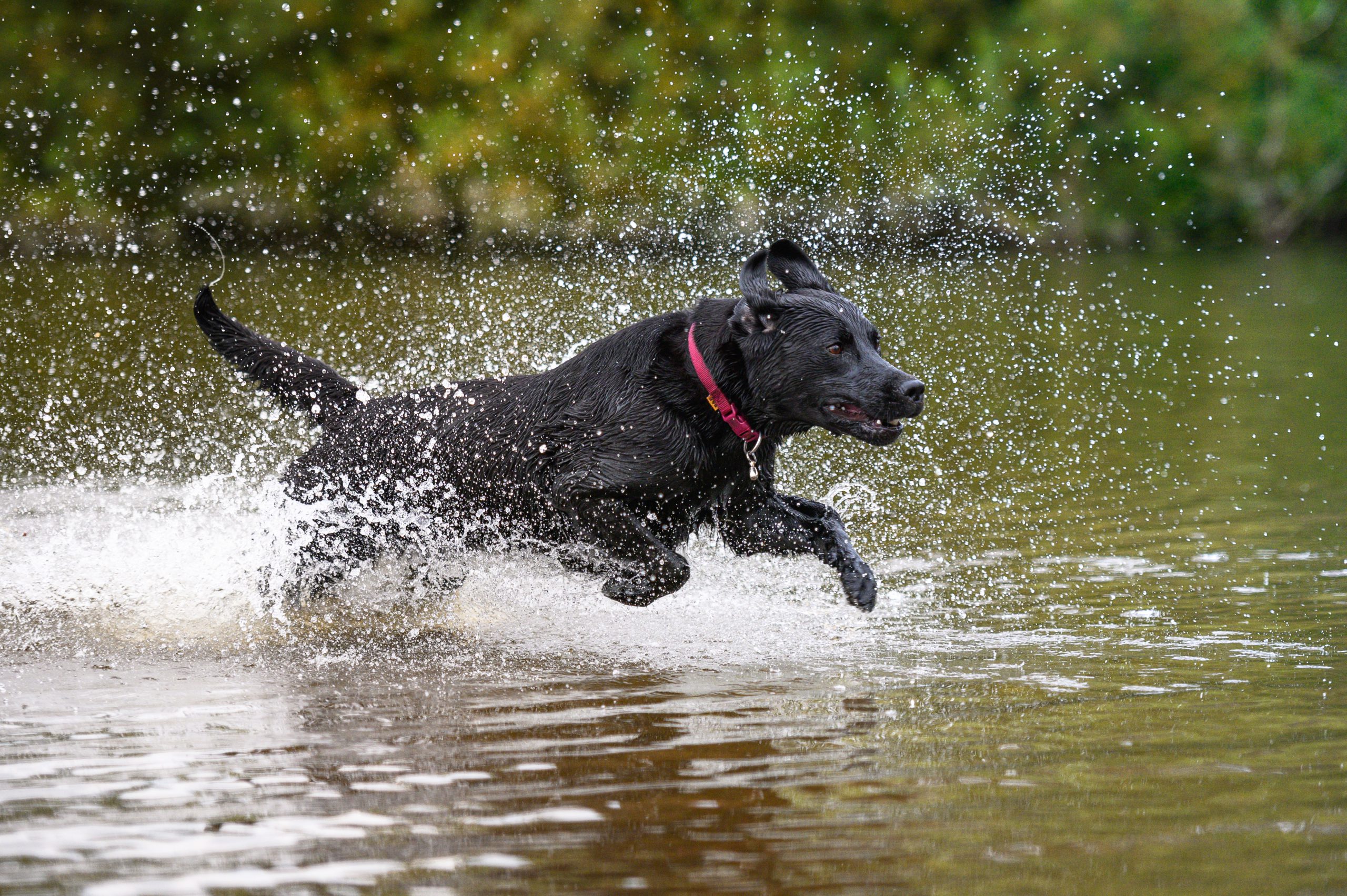Over the years, Rottweilers have earned a reputation for strength and intelligence by driving cattle for ancient Romans, pulling meat carts for medieval butchers, and assisting with modern customs inspections. Their loving, loyal, and surprisingly goofy nature makes them wonderful family companions. But humans who want to live with these imposing, caramel-kissed black dogs should be prepared to harness their strengths and smarts for good.
“Rottweilers are confident and intimidating dogs,” says Dale Green, executive director of For the Love of Dog, a Rottweiler rescue in New Hampshire. “But when they are your best friend, they are marshmallows.” Structure and training are critical. “They are fantastic dogs, but they are not for everybody,” Green adds, with 10-year-old Gunner listening beside her.
For those thinking about welcoming a Rottweiler into their home, and those who already have one and want to better understand the breed, here’s how to unlock the marshmallow.

Benny
Basic Rottweiler facts
The Rottweiler, or “Rottie,” is an athletic, muscular dog that typically stands 22 to 27 inches tall at the shoulder and weighs from 90 to 115 pounds. Rottweilers have wide necks and chests, and ample hindquarters built for speed, which the working breed can use to herd stray livestock—but if yours is with you at a park, make sure they don’t decide it’s better employed to harass innocent pigeons. Wrapping the powerful package is a shiny, medium-length black coat with tan or rust highlights on the face, chest, and legs. A typical Rottie has expressive tan “eyebrows” and a muzzle to match.
Along with a strong body, Rotties possess a strong personality. Fortunately, they are smart enough to understand established rules and assess (some might say “exploit”) any situation. Gunner, who lives in the country, knows to sit and wait for a truck to pass rather than give chase. He also knows he shouldn’t steal socks—and that he can exchange a stolen sock for a cookie.
In his book The Intelligence of Dogs, prolific researcher Stanley Coren ranked Rottweilers ninth in working intelligence—up there with German shepherds (number 3) and Doberman pinschers (number 5) among the most-trainable large-breed dogs. A high ranking indicates that the tested dogs understood new commands quickly, and responded to them reliably—so, on average, a patient, consistent human should find success in training. The The American Kennel Club (AKC) rates Rottweilers as “eager to please.”
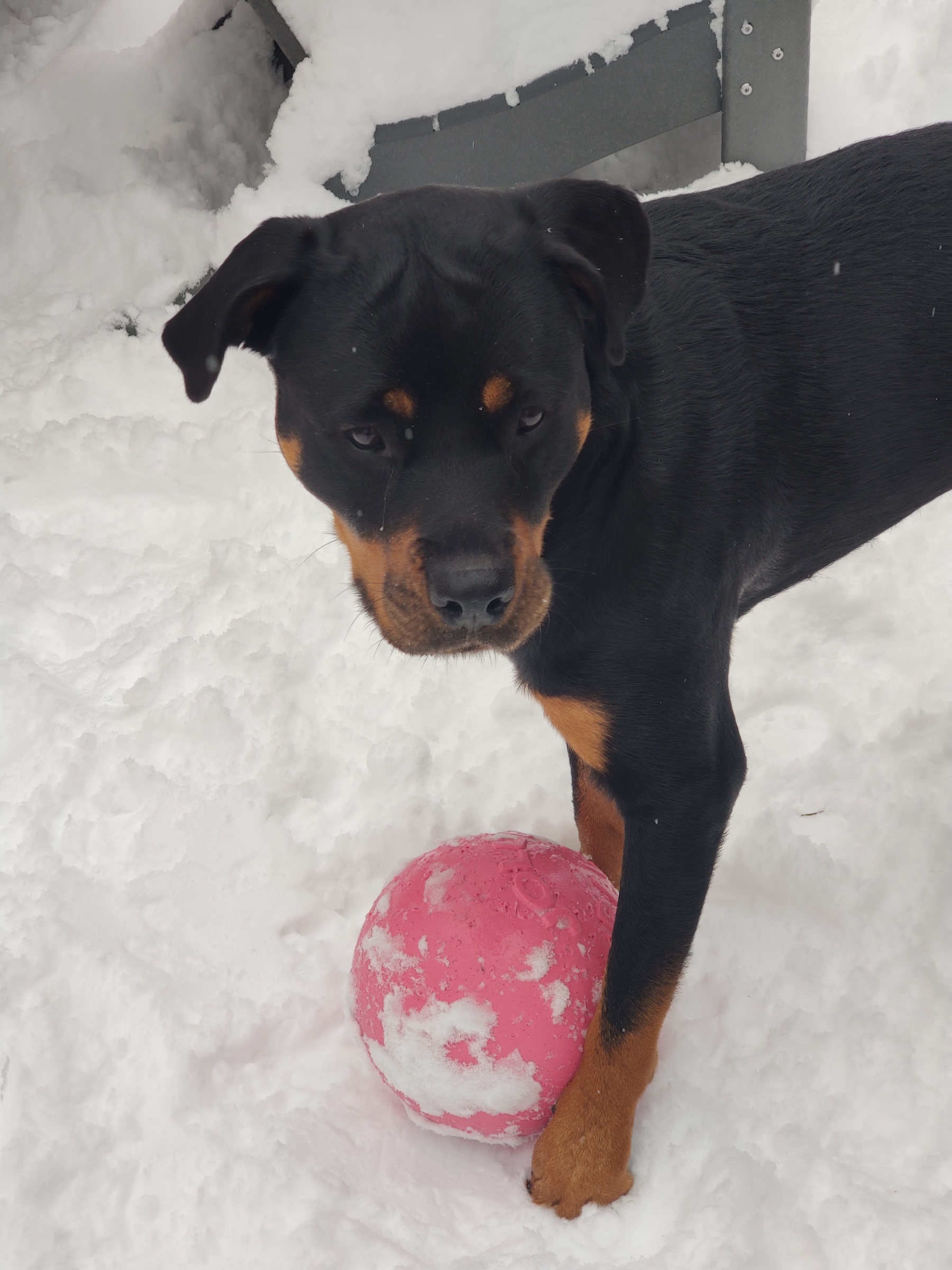
Nutella in the snow
Rottweiler personality
Every dog is different, and breed is no guarantee of a particular personality. However, Rottweiler owners will tell you that they often encounter certain common traits in their pups.
“Nutella is very sassy and isn’t afraid to give you some ‘Rottitude,’” says owner Laura Montini. “She’ll Rottie grumble and huff at you if she wants something.” Nutella is Montini’s first dog, and she has found the experience intense but positive overall, thanks in large part to obedience training. Nutella behaves best when people or other dogs do not approach uninvited. Good manners require proper introductions. “She loves the people she knows, but is quick to alert to unusual sounds and people on her home territory.”
Such affection for familiar humans contrasts with Rotties’ reputation for, at best, aloofness or, at worst, aggression toward strangers. They are, after all, hardwired to protect the flock and the estate. The AKC even advises dog-show judges to “excuse from the ring any shy Rottweiler.” Well-raised and trained Rotties will instinctively nurture and protect other members of your family, and this sometimes-feared dog can make an excellent pet for a family with children. Nevertheless, Rottweilers are powerful, and you should always supervise children and dogs when they’re together.
“He follows everyone from room to room and hates not knowing where everyone is in the house,” says Annabel Chasney of her family’s Rottie, Benny. “We like to say he has major FOMO.” Though the 80-pound dog may look like a tough guy, Chasney says, “He is the sweetest boy and so affectionate with his family.” Witness his preference for greeting each human member of his family with morning wake-up kisses. Her main regret about Rottweiler ownership? “I wish we had invested in a king-size bed! Benny loves to sleep right in the middle of me and my fiancé.”

Nutella on a boat
Rottweiler history: Roman roots
The Rottweiler is named for the German town of Rottweil, where ancient Roman troops stationed nearby introduced the modern breed’s ancestors, which were mastiffs used to herd cattle. After the Romans departed in the second century, the dogs remained and were bred through the Middle Ages as workers that collected livestock, guarded property, and pulled small wagons. They were also known as butcher’s dogs, helping bring carts of meat to market and carrying money in a pouch around the neck. By 1900, the breed was dubbed the Rottweiler metzgerhund, or butcher’s dog of Rottweil.
As the need for pulling meat carts waned, Rottweilers’ athleticism, intelligence, and loyalty enabled them to transition into new careers as security, rescue, and therapy dogs. The modern Rottie came to prominence as a police and military dog. In 1931, the AKC officially recognized the breed, and today it is America’s eighth most popular.
Rottweilers are among the breeds that have been targeted by breed-specific legislation and residential building bans in certain locales. Supporters of the breed note that thousands of Rotties and humans live in harmony, especially if the dog is properly trained and socialized—and the ASPCA opposes breed-specific legislation, arguing that they harm dogs and public safety.
Although there are those who have negative preconceptions about Rottweilers, the AKC rates them as “lovey-dovey” family members, and around average as companions to children and other dogs. Variation between different dogs’ personalities, and different levels of training and socialization, are deciding factors. “Rottweilers, if raised right, are the most gentle, affectionate, and loyal giants out there,” says Christian Del Vecchio, human to Leo. “His comic relief is unbelievable! Leo is an absolute character.” Rotties are usually not big barkers, preferring growls and grumbles if they speak up at all.

Leo (right)
Pop-culture Rotties
Beagles have Snoopy, cocker spaniels have Lady… and Rotties have Carl, hero of the bestselling Good Dog, Carl children’s book series. Author and longtime Rottie enthusiast Alexandra Day modeled the titular canine on her own dog Toby and published the first Carl book in 1985. As “everyone’s favorite babysitter,” Carl’s protective kindness toward his young charge Madeleine promotes a positive association with the breed.
Rotties played supporting roles in National Lampoon’s Christmas Vacation (1989), Alien 3 (1992), and Up (2009). In a less-benevolent role, a Rottweiler was cast as a literal hell hound—Satan’s own envoy on earth—in The Omen (1976). It was an indelible bit of PR that Rotties have had a hard time living down.
Offscreen, the breed is no stranger to real-life Hollywood, as stars such as Miley Cyrus, Leonard DiCaprio, and Sylvester Stallone have owned Rottweilers or Rottie mixes. Will Smith has shared his home with several members of the breed, which he grew to love while growing up in Philadelphia, where they are especially popular (ranking fourth in the city according to the AKC).
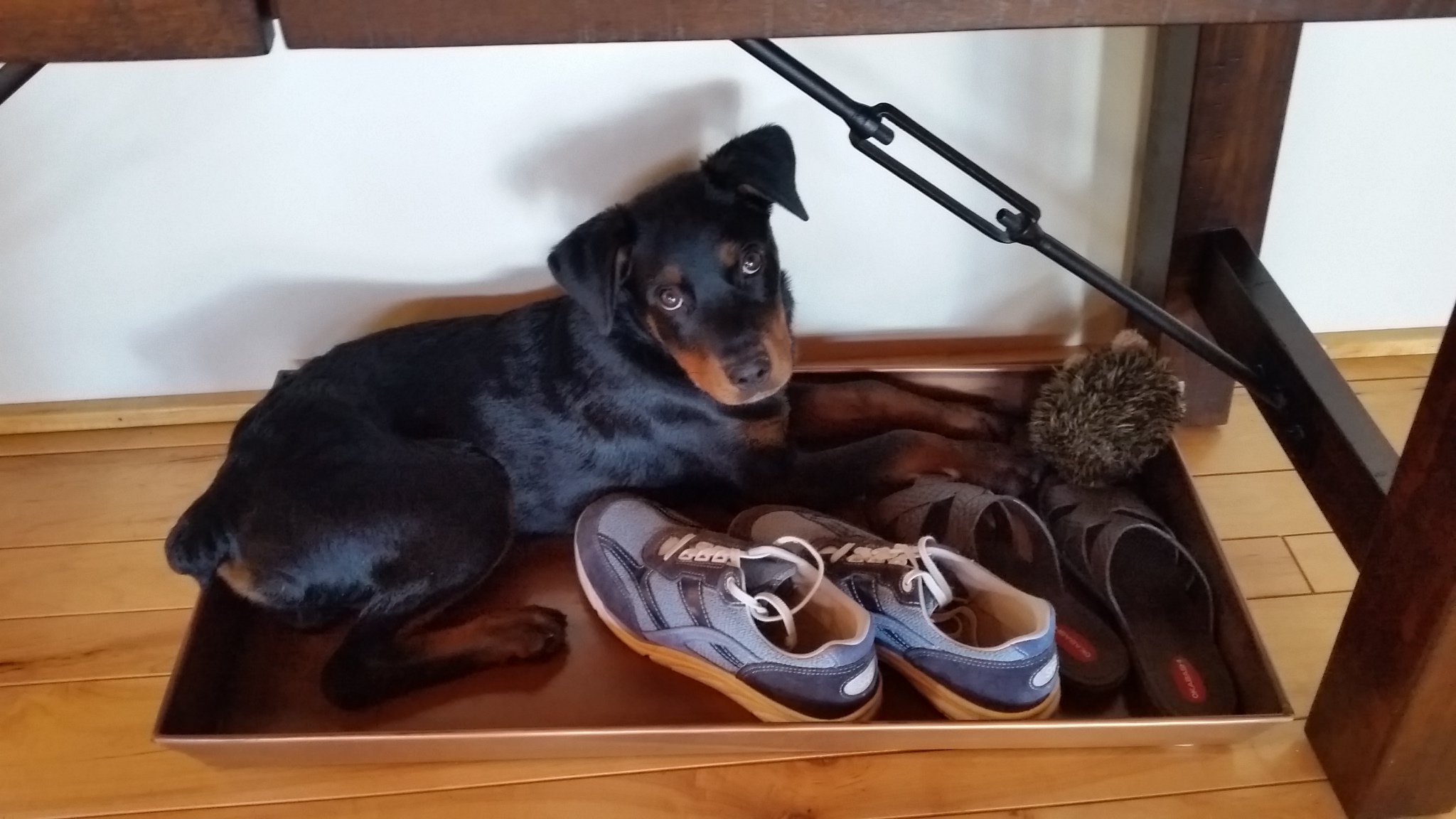
Lucy
Off to school: Rottweiler training
Helpful for any domestic dog, training is critical for an intelligent, athletic breed like the Rottweiler. Early and consistent training is a must, owners emphasize. Kathy Stone says, “I’ve had horses and trained them for years before having a Rottie, so I thought I was ready. I was not.” She and her dog Berrin worked with a trainer, and both found the experience helpful. “I really had to up my game to be more assertive,” she says. When at ease, Berrin will open up and reveal his softer, “goofball” side. “He sings and talks to us almost daily,” Stone says. “When he’s lying beside you and you’re scratching him, if you finish and he’s not done, he’ll touch you with his paw, saying ‘please continue.’”
Begin training and socialization early—and know that the process never ends. “I have a ten-and-a-half-year-old dog and I’m still training him every day,” says Green, who has lived and worked with Rotties for 25 years. “I don’t care how many times you’ve trained a dog, you’re going to attend obedience classes with your Rottweiler.” School needn’t be a drag, however, because Rotties enjoy instruction. Their intelligence and biddability mean they tend to grasp tasks quickly and can also learn to assess a situation. For example, Stone notes, “Berrin will growl at a vehicle, but when he realizes that there are people in it, he becomes excited to say hi.”
Training will also strengthen the bond between owner and dog. By working together, you’ll establish direct (and intuitive) communication skills and set boundaries. Decide on those boundaries early, owners stress. “If you let them on the couch once,” Green says, “you’ll always have a dog that goes on the couch.” Many Rotties are welcome to chill on the sofa—but if that’s not for your family, teach your dog where to lounge instead—make their area a fun, inviting place where they like to spend time. Training should be consistent and firm, but keep it fun.
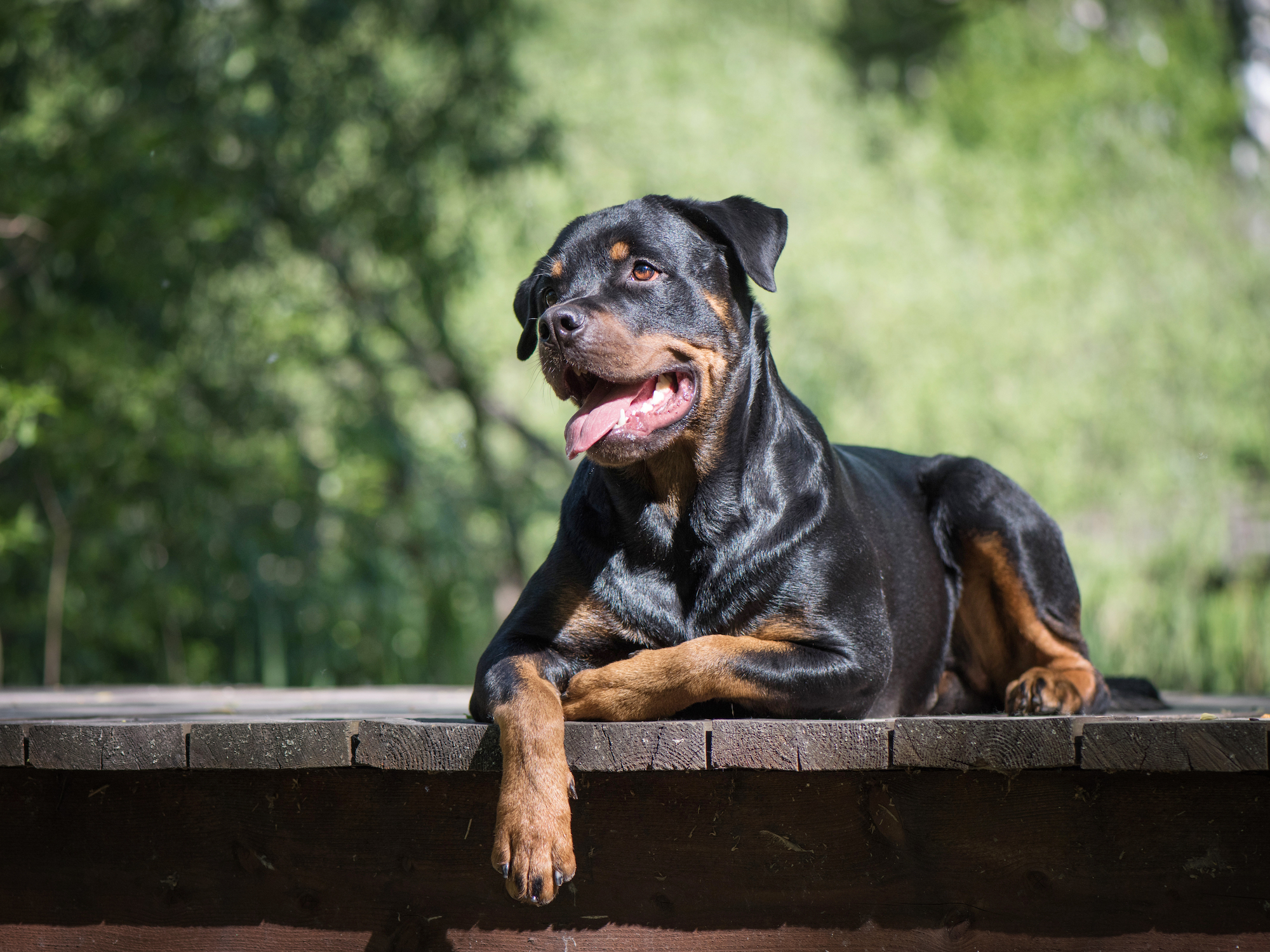
Sports fanatics: Rottweiler exercise
Rottweilers need plenty of exercise to maintain a healthy weight and body condition, and for mental stimulation. Two hours a day is not excessive. If you’re planning to bring home a Rottie, part of your plan should be to consistently provide enough exercise to keep them happy.
“They’re big dogs,” Green says, “so when they’re bored, they’re destructive.” Fortunately, this athletically gifted breed is game for many types of activities with their humans. Walking, of course, but also running, hiking, and swimming. “Carly was introduced to swimming and the pool at a very young age,” owner Jennifer Clark says of her Rottie.“This has been great exercise for her as she does not tolerate the heat well.”
Put the breed’s problem-solving skills to work with games. Though not retrievers, Rotties can be all-stars at fetch and hide-and-seek. Fetch may not even require any instruction, just the toss of a tennis ball. Rotties may sometimes bring owners items that were never tossed in the first place. “The weirdest thing she does is bring me a rock in exchange for a treat,” Tammy Hopson says of her mix Harley. Food puzzles, snuffle mats, and other at-home brain games are also welcome types of enrichment for Rottweilers.
An obstacle course of outdoor furniture is an option for those with a yard. Sidewalks and the local park are great options, provided the pooch is leashed and well-behaved around other dogs and people. Dog parks are a case-by-case situation, depending on whether Rotties are welcome and how your particular dog relates to others. “Rocky loves to walk every day,” Brenda Rodriguez says of her four-year-old Rottie. “He gets super excited and I love it.” Rocky is Rodriguez’s first dog—first pet!—and she went from being neutral about animals to being attached at the hip. “He is always by my side no matter what I do or where I am.”
“It takes a lot to tire Kiwi out,” says Amanda Janouch of her Rottweiler mix. “She can get very needy in the evening if she has not had enough mental stimulation during the day.” Kiwi finds joy exploring the outdoors. “She gets the zoomies anytime she walks through leaves or in the sand,” Janouch says. “She regularly chases her tail and she can chew through almost any toy we put in front of her.”
Of course, even athletic dogs can’t work out all the time. “Lucy loves to watch TV with us, especially if the show has any type of animal,” Hahn says. “She often walks up to the television to get a better view of whatever animal is on the screen.”
Low-maintenance looks: Rottweiler bathing and grooming
With so much exercise, who has time for grooming? The Rottweiler coat—straight and medium length—needs but a weekly brush and regular bathing. Unless your dog gets dirty or smelly, a monthly bath should do. These dogs are moderate shedders, except for the twice-yearly seasonal shift, when your brush and vacuum will work overtime. Drooling can be profuse, and the Pavlov effect often kicks in when food is mentioned or present. Owners note that keeping on top of growing nails is wise. Consider a weekly buzz with a canine nail grinder, and consult with a vet or trainer on how to do this in a manner that won’t cause your pup pain or anxiety.
Common Rottweiler health concerns
Rottweilers are a hearty breed, and those in good health can live from 9 to 10 years. In addition to the challenges most dogs face—obesity being one of the most important to keep an eye on—Rotties are particularly susceptible to the following health concerns.
Arthritis: Common in many breeds and generally more common in large dogs such as Rottweilers, arthritis causes potentially debilitating joint pain. Low-impact exercise and good nutrition in the proper portions can both delay and ease the condition, mainly by helping to maintain a healthy weight. Treatment options include pain medication, glucosamine supplements, and physical therapy, plus modified activity. Watch for changes in movement and expressions of discomfort.
Hip dysplasia: When the components of the hip’s ball-and-socket joint fit improperly, they can grind together in a condition called hip dysplasia, which is common among large breeds like Rotties. As the joint deteriorates, the dog can experience pain and lose mobility. This genetic condition can surface in both puppies and older dogs, often in conjunction with arthritis. Regular exercise and weight maintenance can help prevent and alleviate symptoms. A vet will inspect a Rottie’s hips at checkups and ask if the owner has noticed decreased activity or changes in movement.
Cancer: Rottweilers are predisposed to several types of cancer. As with humans, early detection is key.
Osteosarcoma: Rottweilers have the highest rate of this bone cancer of any breed. Typically striking in middle age, it causes tumors to grow in a dog’s legs. Report any limping or lameness, especially if it arises suddenly, to your vet.
Lymphoma: This blood disease, in which the body makes abnormal white blood cells, affects Rottweilers more commonly than most breeds. Warning signs include swollen glands, breathing issues, or weight loss. On a positive note, your vet can test for lymphoma, and treatment is often effective.
Hemangiosarcoma: Developing without symptoms, hemangiosarcoma arises in cells that normally create blood to deposit tumors in organs like the spleen, liver, heart, and skin. Afflicted dogs can appear healthy—report any sudden changes to your vet so they can investigate.
Cancer is unpredictable, so ensure your dog gets exercise, healthy food, and regular visits to the vet. Cancer treatments include surgery and chemotherapy.
Wobbler syndrome: If vertebrae in the neck narrow, they can pinch the spinal cord and area nerves, which can hinder control of neck and limbs. Early signs of this neurological condition include instability when standing or walking. Medication, braces, and rehabilitation are the main treatment options.
Inflammatory Bowel Disease: Common among Rotties, this disease occurs when immune system cells overrun the intestinal lining, which in turn thickens the lining and stomach and blocks the absorption of nutrients. An afflicted dog may have loose stools or other digestive discomfort, lack of appetite, weight loss, and chronic vomiting. Treatment options for this chronic condition include medication and adjustments to the type and timing of food.
Bloat (Gastric Dilation and Volvulus): Rottweilers are among the breeds most likely to suffer from bloat and gastric dilatation-volvulus (GDV), in which the stomach fills with too much gas and twists onto itself. If you notice unproductive belching or a distended belly in your dog, go to a veterinarian immediately. GDV is a medical emergency and one of the most common causes of death among dogs, and minutes can make the difference between a dog passing away and surviving.
Eye problems: Eye concerns can affect dogs of any breed, but Rottweilers may be particularly susceptible to issues like entropion, cataracts, corneal dystrophy, macroblepharon, and progressive retinal atrophy. Be on alert for any changes to the appearance of your dog’s eyes, as well as any discomfort—perhaps indicated by pawing at that area—or trouble seeing. Keep up with your dog’s regular vet visits to spot any issues early, when treatment may be easier.
Food and nutrition for Rottweilers
Like all dogs, Rottweilers need digestible, complete, and balanced food that supplies enough energy for daily activities, whether walking or snuggling, while helping maintain a healthy weight. The Farmer’s Dog started because of a Rottweiler—Jada, who belongs to our co-founder Brett, experienced ongoing digestive issues before switching to fresh food. Her profound improvement after changing nothing but her food inspired Brett to help more dogs eat healthier so that they could have better lives.
Watch their weight: Many major Rottweiler health concerns, notably arthritis and hip dysplasia, can be positively influenced if the dog maintains a healthy weight. Extra weight puts additional stress on the joints, not to mention the heart, lungs, and metabolism, so it’s important to control portions and calorie intake while ensuring proper nutrition. A fresh-food plan makes it easy to feed the right amount of food for their age, size, and activity level.
Support immunity and joint health: Fresh, lightly cooked food from The Farmer’s Dog provides balanced omega-3 fatty acids, a nutritional powerhouse that can help support a healthy immune system in dogs, and support memory and learning in puppies. A pre-portioned fresh food plan also makes it easy to feed the right number of calories every day. This helps maintain a healthy weight, which is another key factor in keeping joints healthy, as well as improving a dog’s quality of life.
Mind the teeth: Eating for dental health means eating for overall health—a fresh, whole-food diet promotes a healthy immune system, which helps ward off dental maladies. Crunchy kibble is often said to clean teeth, but most kibble does no such thing. In fact, kibble is an ultra-processed food and as such can contain substances that actually fuel inflammation in the body, including in the tissues of the mouth. Most kibble is starchy and full of fillers that break down to sugar, which contributes to plaque and bacteria.
High-quality food for high-quality poops: A diet of fresh, lightly cooked food has been shown to be more digestible than processed kibble, and can promote a healthy gut and good digestion (which also means better, smaller poops).
Know what’s in the bowl: Rottweilers are known for sometimes having sensitive stomachs, so it’s especially beneficial to know exactly what’s in their food. That can be easier to do with fresh, human-food-grade recipes that only contain what’s listed on the label.
A healthy diet—alongside ample exercise, training, vet care, and time together on the couch—is among the keys to giving your Rottie a happy life.
Where to get a Rottweiler
If you have decided to welcome a Rottweiler into your home, a great place to start is a rescue like For the Love of Dog, Rottweiler Rescue of New Hampshire; MidAmerica Rottweiler Rescue; or Rottweilers of Las Vegas Rescue.
